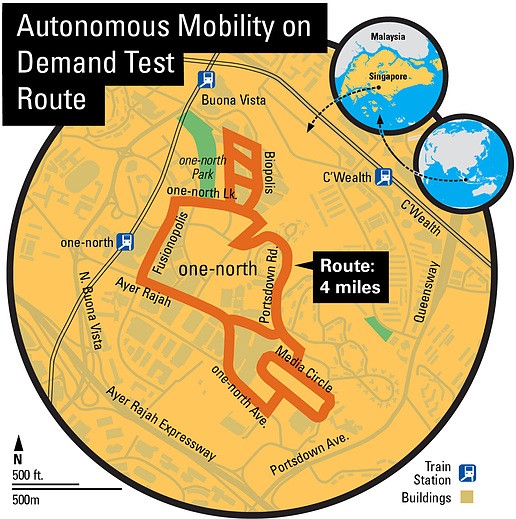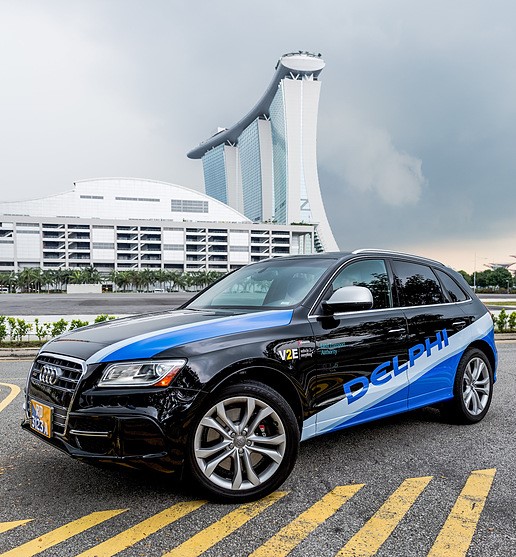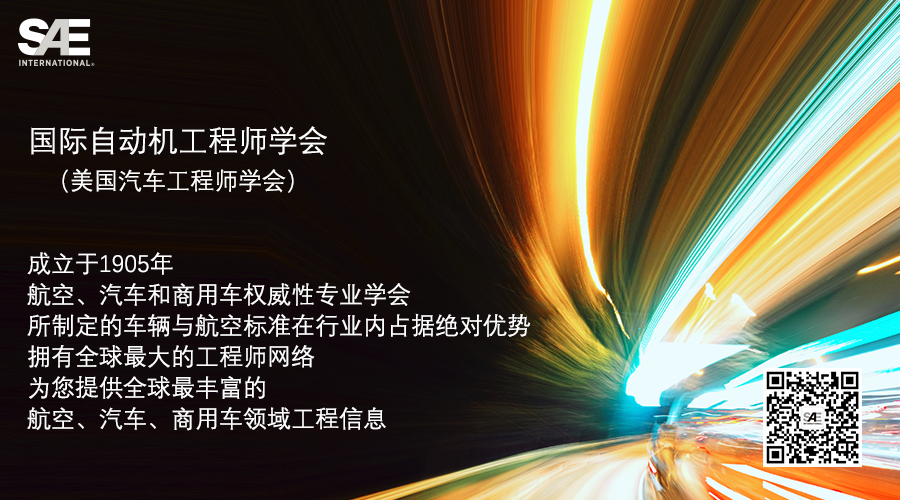 该项目的起始阶段将持续至2019年,届时德尔福公司将在新加坡的自动驾驶车辆开发测试场地纬壹科技城投放6辆将沿固定路线低速行驶的改装量产车型。
该项目的起始阶段将持续至2019年,届时德尔福公司将在新加坡的自动驾驶车辆开发测试场地纬壹科技城投放6辆将沿固定路线低速行驶的改装量产车型。 德尔福公司的Greg DeVos表示,自2019年初,项目将在第二阶段“采用一款真正按需服务的专用自动驾驶车”。
德尔福公司的Greg DeVos表示,自2019年初,项目将在第二阶段“采用一款真正按需服务的专用自动驾驶车”。 德尔福在新加坡自动驾驶测试项目中规划的三条路线的地图。
德尔福在新加坡自动驾驶测试项目中规划的三条路线的地图。 Greg DeVos表示,“奥迪SQ5改装车在自动驾驶道路测试方面取得了巨大的成功”。但截止8月1日本文发布之时,DeVos尚未公布新加坡项目第一阶段测试车队的具体信息。
Greg DeVos表示,“奥迪SQ5改装车在自动驾驶道路测试方面取得了巨大的成功”。但截止8月1日本文发布之时,DeVos尚未公布新加坡项目第一阶段测试车队的具体信息。
德尔福汽车公司的业务服务部门位于美国加里福尼亚州的山景城。8月1日,该部门副总裁Glen DeVos宣布,将在新加坡开展一项广泛的自动驾驶汽车试点项目,旨在2019年底前实现基于云技术的“SAE 第4级-自动驾驶”。
该项目预计将于2022年正式开始。目前,德尔福正在与新加坡道路交通运输管理局(LTA)合作进行一项分阶段完成的项目。在近日举行的一次媒体发布会中,DeVos表示,该项目的起始阶段预计要持续至2019年,届时将在新加坡的自动驾驶车辆开发测试场地纬壹科技城投入6辆将沿固定路线低速行驶的改装版量产汽车。
在试点项目的初始阶段,工程师将作为“安全驾驶员”,陪伴乘坐这些自动驾驶汽车的乘客。DeVos表示,该项目的第二阶段“将采用一款真正可以实现‘按需服务’的专用自动驾驶车辆”。本质上说,第二阶段的自动驾驶车辆可随时响应客户的召唤。DeVos说,当项目完成后,我们就可以“展示一套完整而耐用的‘生态系统’,其中包括数据分析和最终用户的反应”。
今年晚些时候,德尔福将在北美地区新增一个试点项目,未来欧洲试点项目也将开始进行。DeVos解释道,第二阶段的定制车辆支持车门自动开合操作,可以方便残疾乘客的上下车。
德尔福公司总裁兼CEO Kevin Clark在一份声明中表示,AMoD项目将展示公司在自动驾驶软件、多模传感器技术及系统整合方面的专业能力,并同时展现新加坡在互联汽车研发和自动驾驶基础设施建设方面的领导地位。自2014年以来,新加坡自动驾驶汽车计划(SAVI)已经与来自多个行业的合作伙伴建立合作关系,共同开展更多有关自动车和试验台方面的研发。
公司CTO Jeff Owens指出,新加坡的项目将借助德尔福“2015年自动驾驶横穿美国之旅”中使用的多项技术。具体来说,德尔福的这一项目借助一款改装奥迪SQ5实现了横穿美国全境的自动驾驶之旅,是实现Owens所称新型“终端到终端移动解决方案”进程中的一次巨大进步。DeVos指出,那场横穿美国之旅“吸引了新加坡的注意。”
新加坡道路交通管理局正在研究如何协助乘客更加方便地在住宅、公共交通站点和工作场所之间进行日常通勤。他们认为,通过为顾客提供“24/7的按需服务”自动驾驶车辆,解决他们“第一英里”和“最后一英里”的通勤需求,可以提高公共交通系统的使用率,从而缓解新加坡的整体交通拥堵和汽车尾气排放问题。
DeVos断言,“由于前往公共交通站点不方便,所以人们出行时常常选择出租车,而这会使新加坡的交通更加拥堵。”他补充说,按照德尔福的计划,公司自动驾驶车辆的服务对象不仅包括乘客,还可以运送货物。
德尔福在新加坡项目中规划了三条受到严格控制的路线。目前,德尔福仍在寻找“五到六个”供应商作为合作伙伴,其中包括负责云计算平台的公司。DeVos表示,团队中可能包括软件服务公司Mobileye。他说,这种努力“可能最终带来一种以用途为中心的地图服务。”
据了解,为长约7到8公里的行车路线绘制精度在30厘米的地图,预计需要4到6周的时间,其中包括数据汇编工作。
截止本文发表之时,德尔福尚未透露首批测试汽车的具体厂商和车型。
“随着AMoD项目的推进,未来的出行成本将显著下降。”DeVos表示,“我们预计,该项目可以证明我们的[自动驾驶]技术非常稳健,完全可以满足消费者的期望。”
作者:Lindsay Brooke

Delphi launches driverless pilot program in Singapore, aims for Level 4 operation by 2019
Delphi Automotive on August 1 announced an extensive autonomous-vehicle pilot program in Singapore, aimed at demonstrating cloud-based fully automated mobility on demand (AMoD) capability “at the [SAE] Level 4 performance level” by late 2019, said Glen DeVos, Vice President of Delphi’s Business Services Unit based in Mountain View, CA.
Operational capability is expected by 2022. Delphi is partnering with the Singapore government’s Land Transport Authority (LTA) on the multi-phase project. The initial phase, to be conducted through 2019, will involve a fleet of six modified production vehicles operating at low speed on fixed routes in the island nation’s "one north" area, a business park that is currently serving as a test bed for autonomous-vehicle development, DeVos explained in a recent media briefing.
Engineers acting as “safety drivers” will accompany select commuters during the first pilot phase. The program’s second phase “will use a true purpose-built, autonomous mobility-on-demand vehicle,” DeVos said—essentially driverless taxi-pods that can be summoned by customers. When completed the program “will show we have the complete ‘ecosystem’ and durability, including data analytics and reaction by the end consumer,” he said.
Delphi will announce an additional pilot in North America later this year and will also replicate the program in Europe. The second-phase bespoke vehicle will require automated door operation to easily accomodate passengers with physical disabilities, DeVos explained.
Delphi President and CEO Kevin Clark said in a statement that the AMoD project will demonstrate his company’s prowess in automated software, multi-modal sensor technology and systems integration while showcasing Singapore’s leadership in connected-vehicle and autonomous infrastructure. Since 2014 the Singapore Autonomous Vehicle Initiative (SAVI) has increased autonomous-vehicle research and test-bedding with various industry partners.
CTO Jeff Owens noted that the Singapore program will leverage technologies used in the first-ever coast-to-coast U.S. autonomous drive conducted by Delphi in 2015. That project used an Audi SQ5 platform and was a significant step in creating what Owens called “an end-to-end solution” for new mobility markets. The trans-U.S. drive “caught Singapore’s attention,” noted DeVos.
The Singapore LTA is studying ways to assist commuters in their daily round trip from home to mass-transit station to workplace. Offering on-demand automated vehicles on a 24/7 basis for what planners call “the first mile” and “last mile” of the typical commute would, they believe, increase use of mass transit systems and reduce overall traffic congestion and vehicle emissions in the process.
“It’s not easy to get to mass transit in Singapore so people take taxies, increasing congestion in the process,” DeVos asserted. He added that Delphi intends the service to include good and services in addition to people.
Delphi is conducting its own mapping for the three highly controlled routes included in the Singapore project. The company is still finalizing its “five or six” supplier-partners, including that for the cloud platform. The team could include Mobileye, said DeVos. The effort “could possibly lead to a production-intent mapping service,” he said.
Mapping the 7 to 8 km (4.3 to 4.9 mi) of each of the three routes to a 30-cm (12-in) level of accuracy consumed 4 to 6 weeks of time, including data compilation.
Delphi had not yet revealed OEM and models of the initial test-fleet vehicles at the time this article was published.
“With AMoD, the cost of the trip goes down significantly,” DeVos said. “We expect this project will prove our [autonomous] technology is robust and that consumers will use it.”
Author: Lindsay Brooke
Source: SAE Automotive Engineering Magazine
等级
打分
- 2分
- 4分
- 6分
- 8分
- 10分
平均分
- 作者:Lindsay Brooke
- 行业:汽车
- 主题:噪声、振动与声振粗糙度质量、可靠性与耐久性电气电子与航空电子测试与检验
